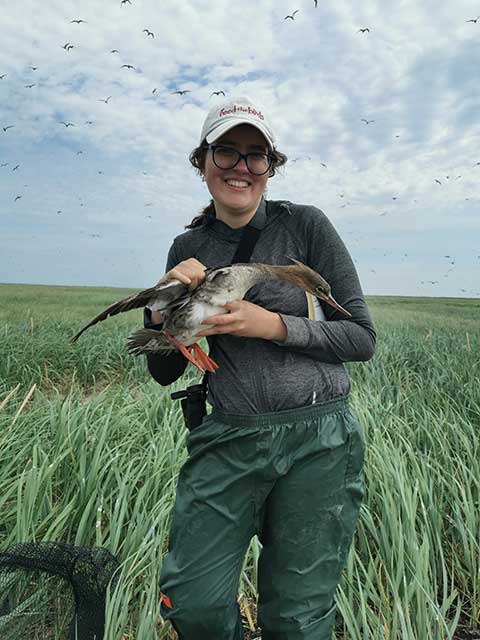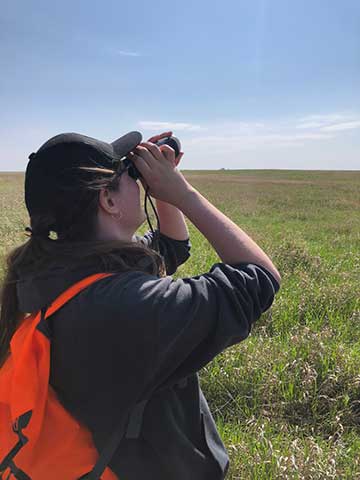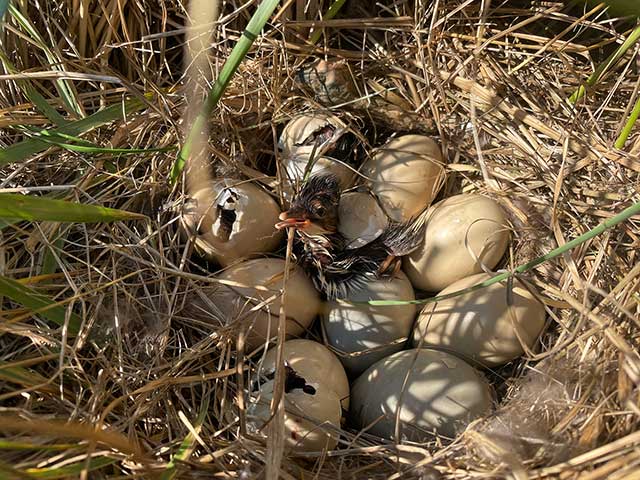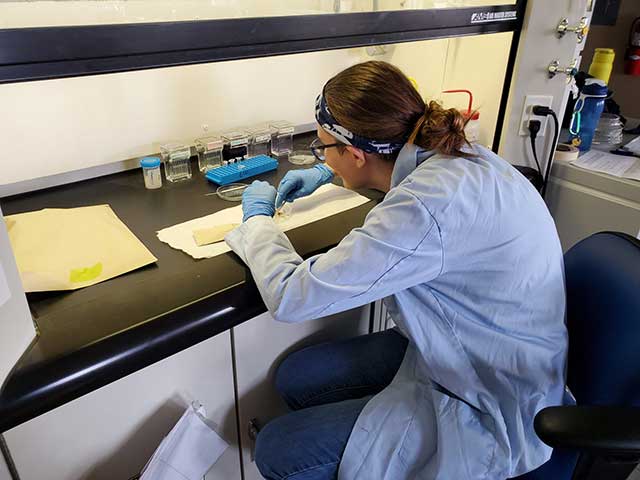
Emily with a Red-breasted Merganser
Emily Burt attends McGill University, where she is a PhD student studying Red-breasted Mergansers. Her research investigates the ecological, social, and evolutionary factors that lead to and promote conspecific brood parasitism in colonially-nesting Red-breasted Mergansers in a coastal archipelago in New Brunswick.
Emily was born and raised in Montreal, Quebec. She knew she wanted to work with animals from a young age, especially birds, and initially hoped to be a bird veterinarian professionally. However, after 10 years as an animal care technician, Emily pivoted away from animal care and studied wildlife biology instead. This led her to McGill University, where she studied environmental biology and specialized in wildlife biology.
Still wanting to work with birds, for her honors project, she chose to work with ornithologist Kyle Elliott, who happened to have a project studying Red-breasted Mergansers in New Brunswick. They breed on two islands in Kouchibouguac National Park, where they nest alongside common terns. The project involved putting GPS accelerometers on breeding merganser hens to study their foraging ecology, movement, and biomechanics. The honors project was a success, encouraged her to continue working with the same population, and introduced her to her future co-supervisors, Shawn Craik and Rodger Titman. Emily began her graduate studies at McGill University as a master’s student, but in 2024, she switched to a PhD program as she wanted to expand her work on Red-breasted Mergansers.

Above: Emily checking an egg for viability in the field.
Below: A Red-breasted Merganser duckling in a nest, from Emily’s field work.

Red-breasted Mergansers are facultative colonial breeders, meaning they do not need to nest in colonies and can nest alone. However, when colonial nesting occurs, it promotes brood parasitism due to the high concentration of nests in small geographic areas. Brood parasitism is a tactic where females lay eggs in another female’s (the host’s) nest and have that hen raise their chick. This reduces their parental care costs and increases their reproductive fitness.
Emily’s graduate work and SDJV fellowship work focus on identifying parasitic hens within the New Brunswick population and investigating how traits such as age, body condition, clutch size, and life history are associated with parasitic behavior. She is also investigating what factors make birds more likely to accept parasitism in their nest and why they haven’t developed anti-parasitism behaviors. While nest parasitism is less costly in waterfowl, since they don’t need to feed ducklings, additional eggs can have negative impacts on nest success, prolong incubation time, and reduce egg survival at high clutch sizes. Emily hypothesizes that hosts may be more willing to accept parasitism if it is by a relative they recognize, as this would indirectly benefit their reproductive success through passing on familial genes.

Emily in the lab
To test this, Emily is using camera traps to record hen behavior. Each hen has a field-readable band, and with DNA from host blood, egg membrane, and embryo samples from each nest, she will be able to link their behavior to their genotype and each duckling to their true mother. She will also be modeling the costs and benefits of parasitism for the host, evaluating genetic structure within the study population, and studying host selection and host-parasite interactions in the nest.
Since 9 out of 15 species of sea ducks engage in brood parasitism, Emily hopes this research will be useful for other sea duck managers by serving as a model system that can be modified and applied to populations of other brood parasitic sea ducks. She also hopes this work will help make population models for these sea ducks more accurate and improve the management of the species.

Two Red-breasted Merganser hens exhibiting nest sharing behavior, from Emily’s field work
Thus far, she has completed three field seasons and collected all of her field data, completed her lab work, and is now focusing on data analysis. Preliminary data show parasites coming by to lay eggs most often when hosts are gone, and that hosts and parasites exhibit different behavioral patterns.
After she finishes her PhD work, she hopes to continue studying waterfowl ecology, especially understudied species like Red-breasted Mergansers. And while she would like to go into academia, she’s also open to working in industry or with an NGO. Outside of work, she enjoys birding (obviously), spending time outdoors, volunteering with bird and animal rescues, and recently took up crocheting.
Follow along in our news section and through our newsletter to keep up with Emily and our other Student Fellowship awardees!
